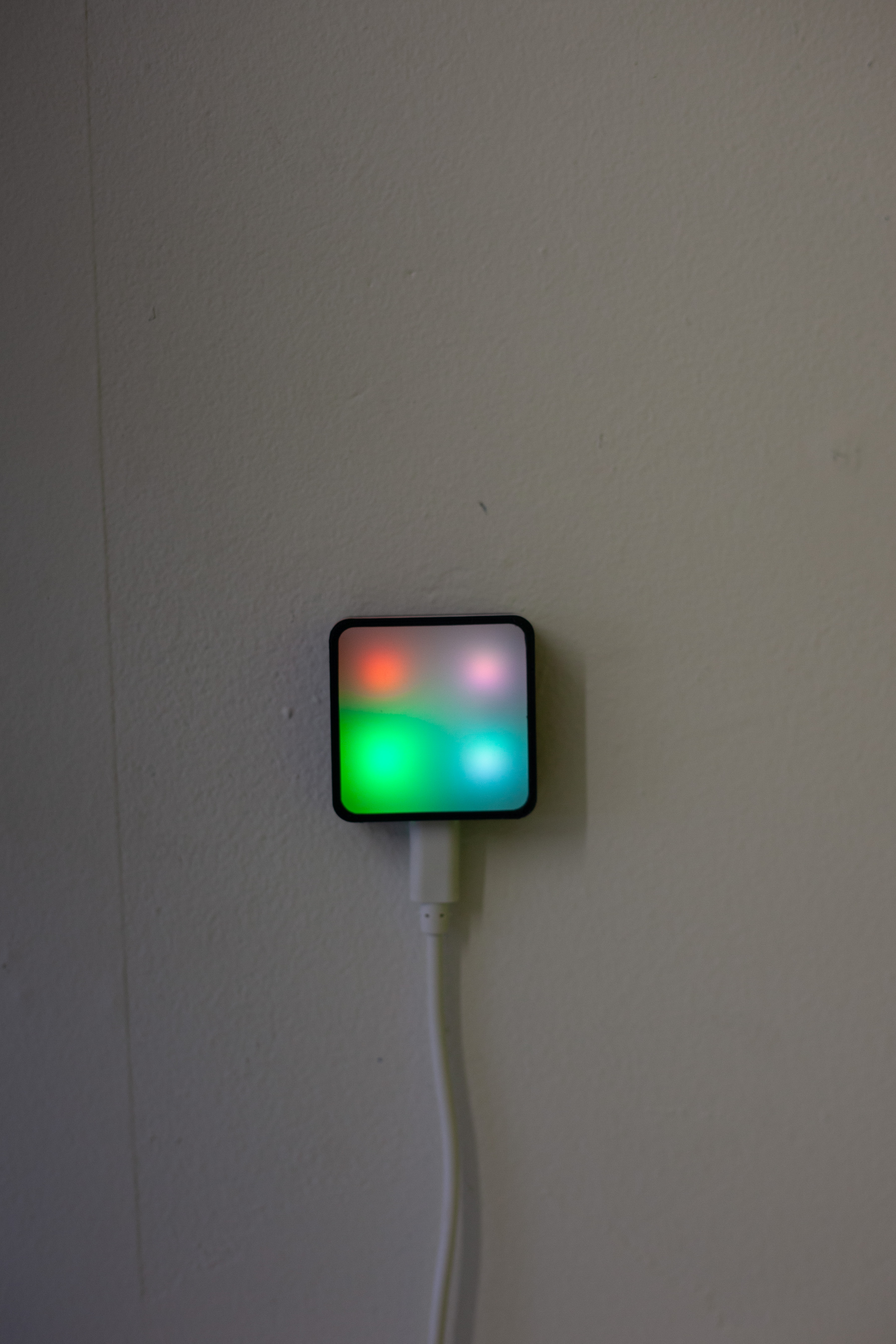

About the Product:
You can buy "self-blinking" LEDs which have tiny brains embedded inside: just power them up, and they blink about 1.5 times a second. But they're not perfectly precise: one might be ever-so-slightly faster than the next.
Each "Sync/Desync Micro" has eight white, self-blinking LEDs, set in an artist-designed white circuit board and a custom 3D-printed frame (two color options included: slate gray and pine). At times, it seems like they're chasing each other, or facing off, or showing patterns. But they have no way of communicating. Each light just blinks on its own, at its own pace; the structures and sequences we perceive are artifacts created by our pattern-sensing minds.
They are boxed with everything necessary to power and wall-mount them (screws or tacks). The artwork is just bright enough to be seen in typical indoor daylight illumination, and comparable to a dim nightlight in darkness.
To my mind, a lot of modern life boils down to finding patterns: matching things together, making theories that fit the data. Yes or no, us versus them. This was a useful talent for hunter-gatherers: seeing a pattern in the underbrush could mean the difference between eating or starving. But today I suspect that we detect less helpful patterns. We find signals in the noise, whether it's there or not; Skinner's pigeons, hopping one-footed.
Though the lights are dim, they may interact with photosensitive epilepsy.
Chris Combs
Sync/Desync Micro
Size: 2.5 x 1 x 1/4 inches
Medium: Self-blinking LEDs, PLA, custom circuit board




About the Product:
You can buy "color-changing" LEDs which have tiny brains embedded inside: just power them up, and they slowly course through the colors of the rainbow. But they're not perfectly precise: one might be ever-so-slightly faster than the next.
Each "Sync/Desync R/G/B Micro" has four color-changing LEDs, set in an artist-designed circuit board and a custom 3D-printed frame (two color options included: slate gray and pine) with an acrylic diffuser. At times, it seems like the colors are coordinating, or clashing, or chasing each other around. But the lights have no way of communicating. Each just slowly changes on its own, at its own pace; the structures and sequences we perceive are artifacts created by our pattern-sensing minds.
They are boxed with everything necessary to power and wall-mount them (screws or tacks). The artwork is bright enough to be seen in typical indoor daylight illumination, and comparable to a regular nightlight in darkness.
To my mind, a lot of modern life boils down to finding patterns: matching things together, making theories that fit the data. Yes or no, us versus them. This was a useful talent for hunter-gatherers: seeing a pattern in the underbrush could mean the difference between eating or starving. But today I suspect that we detect less helpful patterns. We find signals in the noise, whether it's there or not; Skinner's pigeons, hopping one-footed.
Sync/Desync R/G/B Micro
Size: 2x2x3/4" 5x5x2cm WxHxD
Medium: Color-changing LEDs, acrylic, wood PLA, custom circuit board
Note: Delivery times vary based on production. You will be notified with your purchase.
Size: 2x2x3/4" 5x5x2cm WxHxD
Medium: Color-changing LEDs, acrylic, wood PLA, custom circuit board
Note: Delivery times vary based on production. You will be notified with your purchase.
About the Artist:
Chris Combs is an artist based in Washington, D.C and Mount Rainier, Maryland who creates provocative technology. His recent solo show Lossiness at VisArts featured seven artworks exploring the boundaries of human perception. Judging Me Judging You at the DC Arts Center explored themes of surveillance and control, and his installation Maelstrom at Rhizome DC featured 35 machines spreading rumors about its visitors. "Madness Method," a large-scale collaboration with David Greenfieldboyce, was part of the Georgetown GLOW public art festival. He was selected as the Derek Lieu Spring 2020 Artist-in-Residence at HOLE IN THE SKY, and is a two-time recipient of the DC CAH Arts and Humanities Fellowship program. He was shortlisted for the 2021 Aesthetica Art Prize. Chris is a graduate of the Corcoran College of Art + Design, and was a photo editor for National Geographic. He is a member of the Otis Street Arts Project. You can find his work at chriscombs.net.
Chris Combs is an artist based in Washington, D.C and Mount Rainier, Maryland who creates provocative technology. His recent solo show Lossiness at VisArts featured seven artworks exploring the boundaries of human perception. Judging Me Judging You at the DC Arts Center explored themes of surveillance and control, and his installation Maelstrom at Rhizome DC featured 35 machines spreading rumors about its visitors. "Madness Method," a large-scale collaboration with David Greenfieldboyce, was part of the Georgetown GLOW public art festival. He was selected as the Derek Lieu Spring 2020 Artist-in-Residence at HOLE IN THE SKY, and is a two-time recipient of the DC CAH Arts and Humanities Fellowship program. He was shortlisted for the 2021 Aesthetica Art Prize. Chris is a graduate of the Corcoran College of Art + Design, and was a photo editor for National Geographic. He is a member of the Otis Street Arts Project. You can find his work at chriscombs.net.


